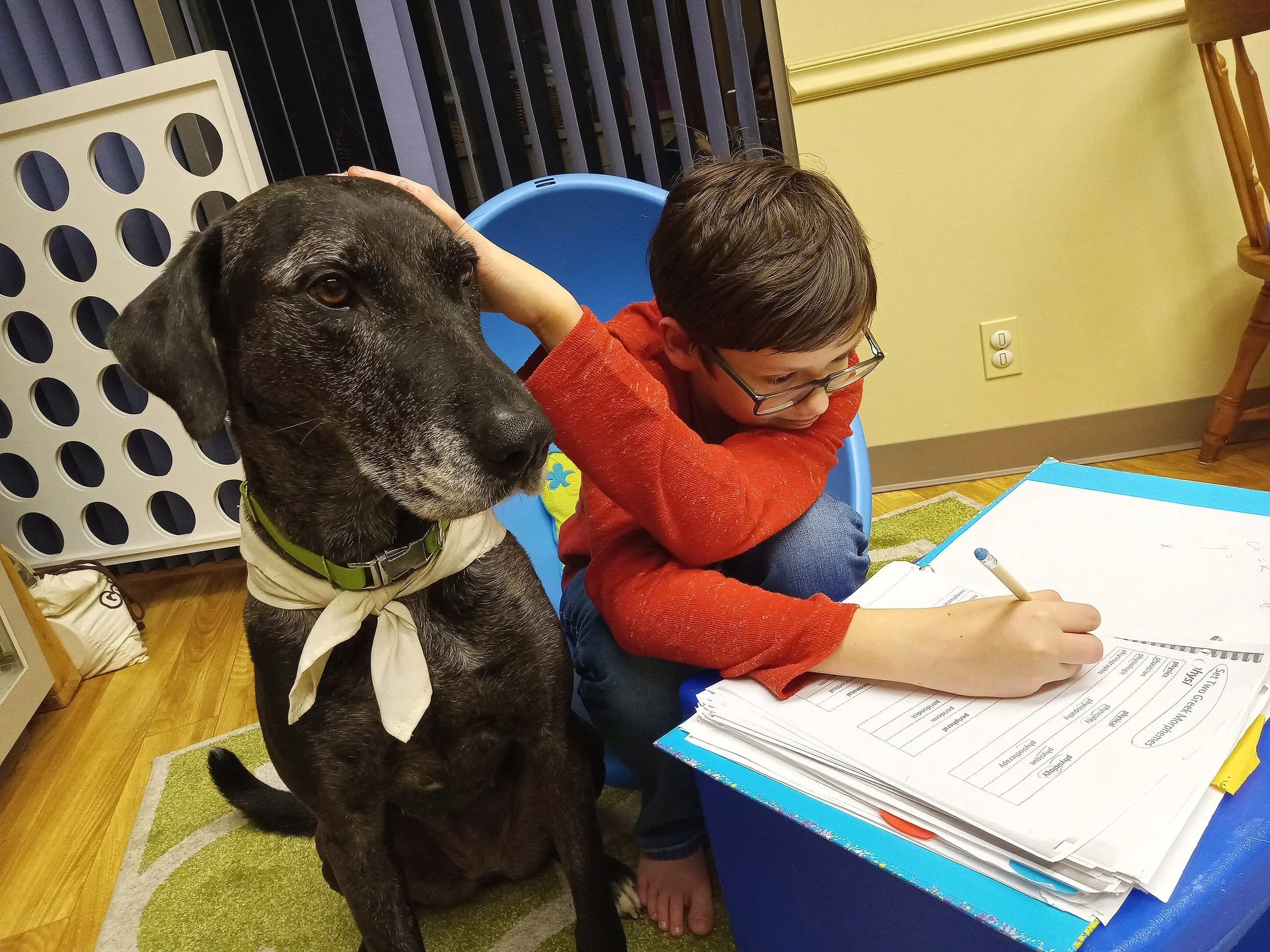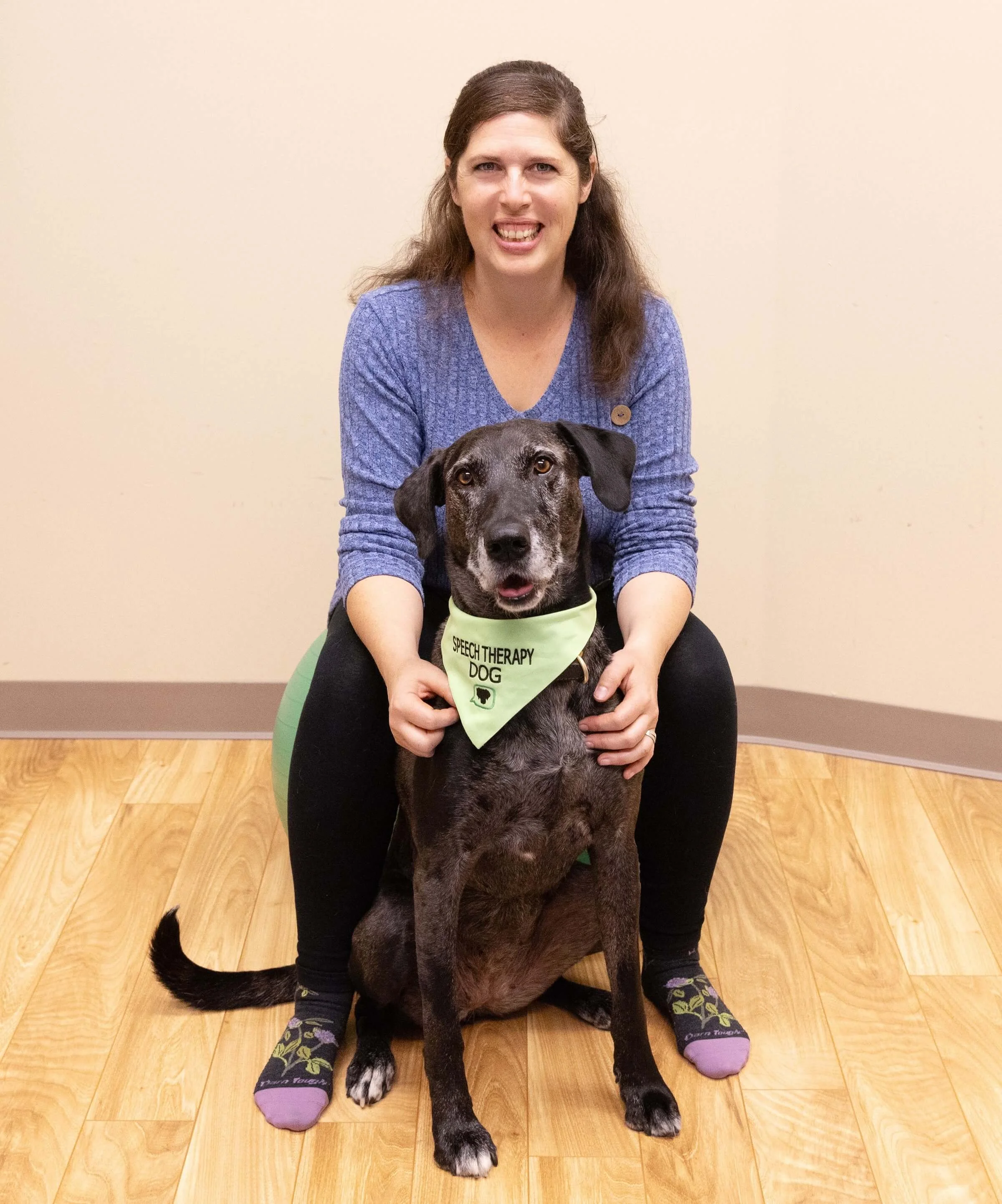More or Less: How a Speech Therapy Dog’s Role May Change Over Time
"It is amazing how much love and laughter [dogs] bring into our lives and even how much closer we become with each other because of them." – John Grogan, author of "Marley & Me"
It was with a little sadness that I reflected back over my last five years with Paul* as his “graduation day” from speech therapy approached.
The client who started this whole journey.
The first client Delta met.
The client whose bond with her convinced me to explore partnering with a speech therapy dog on a regular basis.
(*Not his real name. For the full story, see My Journey to Animal-Assisted Speech Therapy)
In those first months and years, having Delta (and later therapy dogs Johnny Utah and Bodhi) present was pivotal in encouraging Paul to engage with me and persist in challenging activities. The dogs:
provided calming input,
acted as memorable characters in simple skits to illustrate new concepts,
provided non-judgmental listening as he tried putting new skills into practice, and
helped me develop rapport as we shared in our mutual love of the dogs and laughed at their antics together.
But over the past couple years, Delta’s role in Paul’s therapy sessions had transitioned. He still greeted her with enthusiasm, but with challenging oppositional behaviors now rarely cropping up, Delta generally spent her time lying on her bed nearby while he worked away at the table.
It’s only been in meeting other professional therapy dog handlers that I’ve come to realize this a normal, and even desired, outcome of animal-assisted therapy. Let’s explore how a decreased reliance on a therapy dog can evolve naturally as well as how some clients may actually increase their interactions with a therapy dog over time…
Delta, my first speech therapy dog, provides support and sensory input to help a client stay calm and focused while participating in animal-assisted speech therapy.
If you click a link it’s likely an affiliate link and I will earn a small commission for your purchase. It doesn’t cost you anything extra. If I don’t use and love a product, you won’t find it here!
Decreased reliance on a speech therapy dog
While I wasn’t consciously aware of this process at the time it was first happening, I realize now that the human-animal bond Paul developed with Delta allowed for a gradual transfer to a human-human bond with me.
Having the therapy dogs present provided a positive association to arriving at speech therapy for Paul, which in turn meant that when he arrived he was less likely to be in a state of fight-flight-freeze (sympathetic nervous system response).
For the several months prior to first introducing Delta into sessions, Paul would arrive “fighting mad” for no apparent reason, poised to avoid nearly every request, refuse assistance in understanding new concepts, and sometimes even physically lash out. This is how Paul experienced life in general and was why “maybe try speech therapy?” had been suggested by a flummoxed teacher when Kindergarten year had turned abysmal for all involved.
But in Delta’s presence he naturally entered a caregiver mode, talking to her adoringly, ensuring she had plenty of treats and scratches, and displaying an intense degree of empathy he wasn’t able to express towards the humans in his life.
Delta in turn gave him physical contact I couldn’t have, initially by lying against him, often with her head on his lap. Later, as I learned more about animal-assisted therapy, Paul helped me teach her to give deep pressure input by lying across his lap or back as part of a routine to start our sessions off in a more regulated sensory state.
And though he used to react explosively if I tried to compliment his work, I had found he would smile if I directed my positive comments to Delta instead, such as, “Did you see how smoothly Paul read that sentence, Delta? He has worked so hard on that!”
I can’t pinpoint when it happened, but at some point over those years Paul gradually became less reactive and more open to trying new ideas, discussing challenges, and accepting feedback. Until one day he had met all his oral and written communication goals, was succeeding in a full general education placement at school, and his family felt ready to try life without our weekly therapy appointment.
I can’t say for sure if Paul and I would have eventually achieved the same success without the assistance of my speech therapy dogs. After all, Paul received a lot of help from a lot of different professionals over the years.
I’ve had the privilege, however, to see similar changes play out with several other clients who tend to be more resistant and avoidant as a default setting.
I credit the presence of my speech therapy dogs with the changes I’ve seen in these kids.
Increased benefits from including a speech therapy dog over time
On the other hand, I’ve worked with kids who were initially unable to benefit from working with my speech therapy dogs because they were either nervous or less aware of their presence, but over time developed a positive interest in the dogs.
Shreyan, featured in my video Supporting Clients with Approach-Avoidant Behaviors in Animal-Assisted Therapy, was initially so hypervigilant that Delta might approach that we kept her behind a barrier for several sessions. He was highly interested in petting her, but perseverated on asking if she was going to bite.
(For more information, see also When a Therapy Dog Brings Worries: Helping Kids Overcome Mild Fears During Animal-Assisted Speech Therapy.)
With explicit teaching of how to interact with Delta, however, Shreyan came to look forward to her inclusion in our sessions and now readily practices forming grammatically correct questions to ask her, practicing perspective taking based on what we’ve discovered about her, and advocating for his sensory needs by asking her for either more personal space or deep pressure “squishes” as he desires in the moment.
After our first session together I honestly wasn’t sure if animal-assisted speech therapy would be an appropriate fit for this particular client, but I’m glad his family and I gave it a try. I anticipate it will open up a lot of opportunities for Shreyan to practice his improving language and social communication skills.
Speech therapy dog Delta provides turn-taking opportunities for a client taking part in animal-assisted speech therapy.
Potential for benefits from animal-assisted speech therapy as a child’s engagement skills change
I’ve also worked for the past year with a toddler with autism who for several months didn’t seem to really notice when one of my dogs (or other people for that matter) was present, preferring instead to wander the office looking at the walls in his peripheral vision.
We’ve worked a lot on joint attention and engagement through active play in the sensory room while Delta or Sky rested.
Now more engaged with the humans in the room and starting to meaningfully direct some spoken words, this little guy has recently begun to notice when my therapy dog approaches, reaching out to pet (with close supervision) and even occasionally saying “hi” in imitation.
Watching Delta run through a tunnel really grabbed his attention a few sessions ago. Since he also enjoys crawling through the tunnel, we were able to get a few minutes of mutually enjoyable turn-taking .
It remains to be seen how much of a role animal-assisted therapy will play in this particular child’s therapy, but it seems possible that Delta, Sky, and perhaps even a future therapy dog will provide opportunities for him to meaningfully practice developing communication skills in years to come.
If you’re interested in further exploring the potential benefits of partnering with a speech therapy dog, follow on Instagram @Speech_Dogs and check out Paws for Progress: Integrating Animal-Assisted Interventions Into Your Speech-Language Pathology Practice now available from ASHA Press!
Don’t forget to take advantage of your FREE Roadmap to Partnering with a Speech Therapy Dog available on the Speech Dogs site.
May your days be filled with puppy wiggles and children’s giggles,
Sharlet



